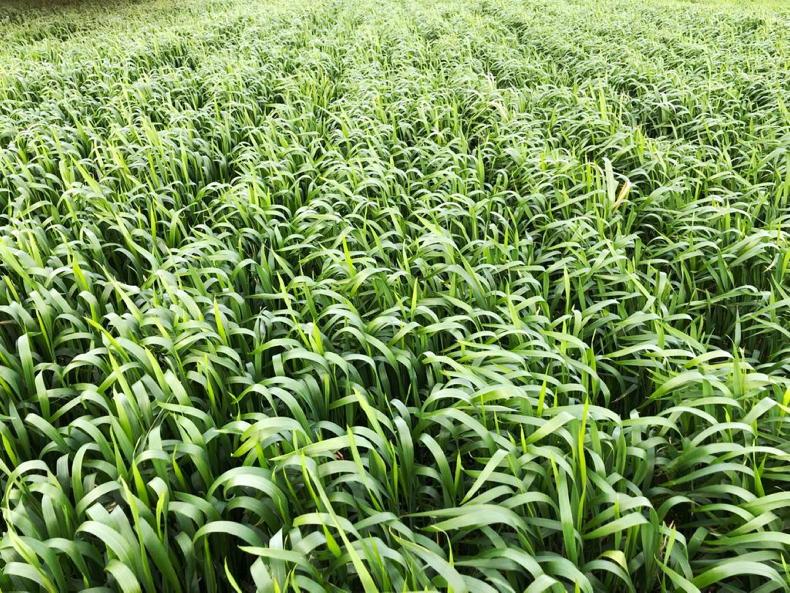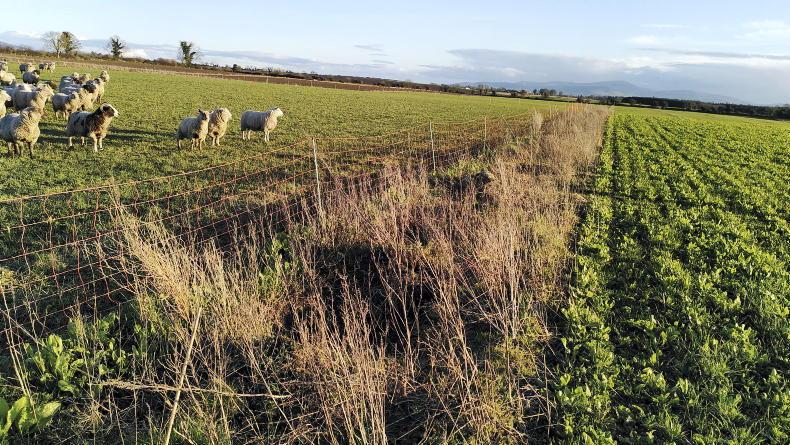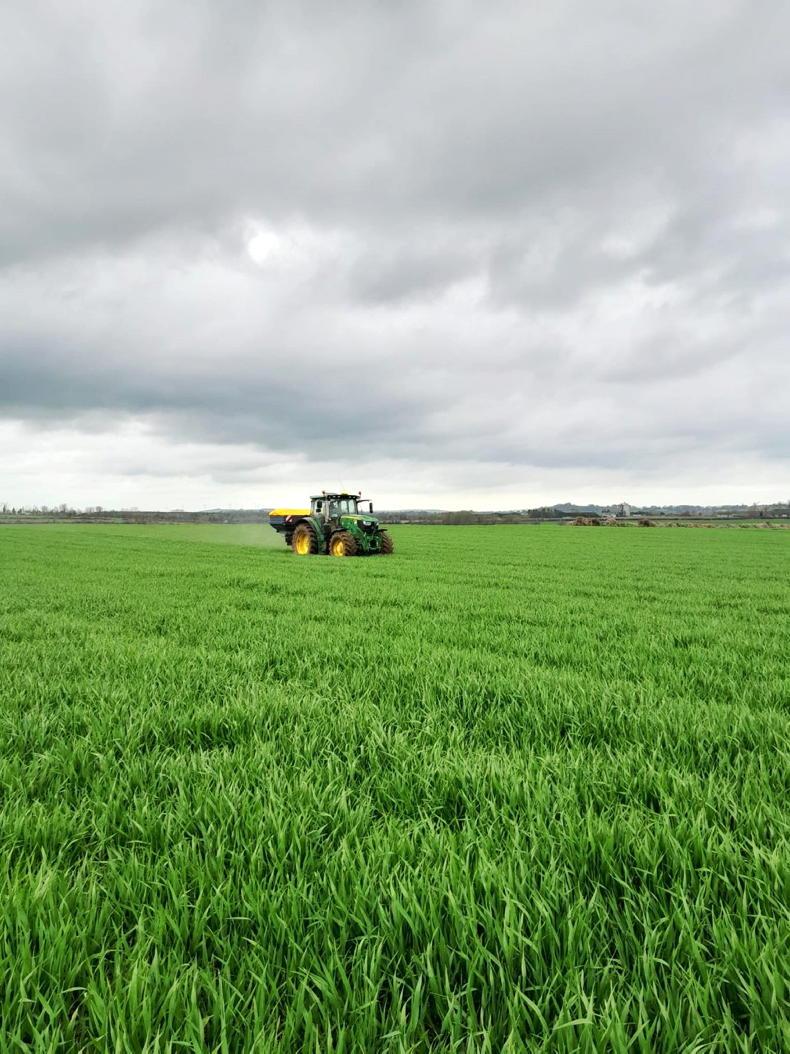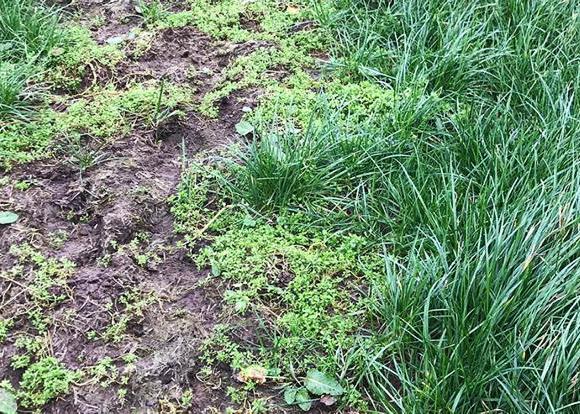Tony Bell has been able to get some field work completed over the past couple of weeks, despite the heavy rain. Land is holding up well and is trafficable, something Tony puts down to his strip tillage system.
Tony’s Graham winter wheat crop established well and received a herbicide of Alister and Zypar in January, with excellent control. The wheat has received 40kg N/ha so far. This was applied as urea where spent mushroom compost was spread last autumn, or 10-7-25 where it was not.

Forage triticale on Tony Bell's farm. It will be chopped for silage within 10 days.
Tony notes that there is a large cost difference between the urea and compound. The wheat will receive a growth regulator and amino acid this week.
He might also apply some N16 foliar nitrogen.
Tony finished drilling spring beans just as the rain began on 8 March. He has sowed around 350ac on his own farm and for hire. The beans were sowed four inches deep by his Czajkowski strip till drill into stubble, ploughed ground and cover crops, and are now just beginning to emerge.
The drill’s legs were working 10 inches deep, and Tony says that this eliminated compaction and allowed water to drain away quickly, with no water pooling on these fields.
They were sprayed with Stomp Aqua (2l/ha) and Emerger (2l/ha) up to seven days post-sowing.
The triticale sowed last September will be mowed and ensiled in two weeks once the flag leaf has fully emerged. Some 25l/ha of N16 and amino acid was applied four weeks ago, and it received 125kg/ha of urea two weeks ago.
The crop also received 3l/ha of sulphur to promote nitrogen use and protein creation, and tebuconazole to control rust.
Tony is trying to improve the protein content of the triticale silage from its usual 11.5%. The crop has 30% DM and 78% DMD making it a very high-quality animal feed. Strip-till maize will then be planted.
Jack is waiting patiently for the ground to dry before he plants his organic milling wheat and oats.
It has been very wet, but Jack’s land is relatively free draining, and should dry up quickly this week.
He has kept busy planting trees in his agroforestry project, doing paperwork, and ordering seed so he is ready to start fieldwork when the weather allows.
The sheep have finished grazing the multispecies swards on the farm. They were mob grazing and were moved weekly over the winter months. This provided weed management, soil fertility, and additional income to Jack’s farm.

Sheep grazing a multispecies sward beside a row of newly planted trees.
Jack shallow disced his land in the dry spell in January in order to create a stale seedbed. This allows weeds to germinate, which were then killed by another run of a disc in early March.
Another flush of weeds will then be killed by the drilling of the crops. This stale seedbed is crucial in a min-till system on an organic farm. The crops will also be weeded with a Weaving harrow once planted, both pre- and post-emergence.
While minimum tillage is challenging, especially with grass weeds, it worked successfully for Jack last year. He will be growing WPB Isabel spring oats and Sharki milling wheat this year.
Jack has planted rows of fruit and nut trees with 24m of tillable land between each row, and each row measuring 3m wide as part of his agroforestry plan, mainly apples, plums, pears, cherries, peach, medlar, quince, hazelnut, sweet chestnut and walnut.
Alder is also planted in these rows to fix nitrogen and to give shelter.
There are two wider rows which are home to native and timber tree species.
Jack will continue to plant trees this year. Some of the fruit and nut trees will also need pruning, with a lot of biomass growing since they were planted last year.
Mark has made it back out on to the fields this week after having some good drying days since Saturday. He has spread slurry before ploughing on to ground destined for spring oats and fodder beet.
Mark has Belfry, SY Armadillo, and KWS Tardis winter barley on his farm this year. All of his barley has a great colour to it and has come through the winter well.
It has received two splits of fertiliser, a compound fertiliser and urea, and currently sits at 150kg N/ha. The crop also received its first spray during the week, with growth regulators CeCeCe 750 (1l/ha) and Moxa EC (0.2l/ha) included, two fungicides, Decoy 250EC (0.5l/ha) and Modem (0.6l/ha), and trace elements including zinc and manganese at 1l/ha.

Belfry winter barley receiving nitrogen on Mark Hally's farm.
The Graham winter wheat on the farm also looks good at present. It has received 430kg/ha of 13-5-25 so far.
At the time of speaking with Mark, it was planned to spray the wheat this week if field conditions allowed. It is receiving its herbicide of Alister (0.8l/ha) and Fluxyr (1l/ha), with the adjuvant Biopower (0.8l/ha) also included.
Mark has both Husky and WPB Isabel winter oats on the farm and is happy with the condition of the crop at the moment. It has also received 430kg/ha of 13-5-25. It received a growth regulator of CeCeCe 750 (1l/ha), a fungicide of Midas (0.3l/ha), and a herbicide of Inka Max SX (32g/ha). It also received trace elements.
Spring beans were drilled on the farm at the beginning of March into good conditions. The variety is Lynx. These beans have just emerged now. They were rolled after sowing and received a pre-emergence herbicide of Nirvana at 4l/ha.
Mark hopes that his fields will have dried enough by this weekend, pending forecasted rain on Wednesday, to allow him to plough and sow his SY Amity spring malting barley for Dairygold and some spring oats.
Tony Bell has been able to get some field work completed over the past couple of weeks, despite the heavy rain. Land is holding up well and is trafficable, something Tony puts down to his strip tillage system.
Tony’s Graham winter wheat crop established well and received a herbicide of Alister and Zypar in January, with excellent control. The wheat has received 40kg N/ha so far. This was applied as urea where spent mushroom compost was spread last autumn, or 10-7-25 where it was not.

Forage triticale on Tony Bell's farm. It will be chopped for silage within 10 days.
Tony notes that there is a large cost difference between the urea and compound. The wheat will receive a growth regulator and amino acid this week.
He might also apply some N16 foliar nitrogen.
Tony finished drilling spring beans just as the rain began on 8 March. He has sowed around 350ac on his own farm and for hire. The beans were sowed four inches deep by his Czajkowski strip till drill into stubble, ploughed ground and cover crops, and are now just beginning to emerge.
The drill’s legs were working 10 inches deep, and Tony says that this eliminated compaction and allowed water to drain away quickly, with no water pooling on these fields.
They were sprayed with Stomp Aqua (2l/ha) and Emerger (2l/ha) up to seven days post-sowing.
The triticale sowed last September will be mowed and ensiled in two weeks once the flag leaf has fully emerged. Some 25l/ha of N16 and amino acid was applied four weeks ago, and it received 125kg/ha of urea two weeks ago.
The crop also received 3l/ha of sulphur to promote nitrogen use and protein creation, and tebuconazole to control rust.
Tony is trying to improve the protein content of the triticale silage from its usual 11.5%. The crop has 30% DM and 78% DMD making it a very high-quality animal feed. Strip-till maize will then be planted.
Jack is waiting patiently for the ground to dry before he plants his organic milling wheat and oats.
It has been very wet, but Jack’s land is relatively free draining, and should dry up quickly this week.
He has kept busy planting trees in his agroforestry project, doing paperwork, and ordering seed so he is ready to start fieldwork when the weather allows.
The sheep have finished grazing the multispecies swards on the farm. They were mob grazing and were moved weekly over the winter months. This provided weed management, soil fertility, and additional income to Jack’s farm.

Sheep grazing a multispecies sward beside a row of newly planted trees.
Jack shallow disced his land in the dry spell in January in order to create a stale seedbed. This allows weeds to germinate, which were then killed by another run of a disc in early March.
Another flush of weeds will then be killed by the drilling of the crops. This stale seedbed is crucial in a min-till system on an organic farm. The crops will also be weeded with a Weaving harrow once planted, both pre- and post-emergence.
While minimum tillage is challenging, especially with grass weeds, it worked successfully for Jack last year. He will be growing WPB Isabel spring oats and Sharki milling wheat this year.
Jack has planted rows of fruit and nut trees with 24m of tillable land between each row, and each row measuring 3m wide as part of his agroforestry plan, mainly apples, plums, pears, cherries, peach, medlar, quince, hazelnut, sweet chestnut and walnut.
Alder is also planted in these rows to fix nitrogen and to give shelter.
There are two wider rows which are home to native and timber tree species.
Jack will continue to plant trees this year. Some of the fruit and nut trees will also need pruning, with a lot of biomass growing since they were planted last year.
Mark has made it back out on to the fields this week after having some good drying days since Saturday. He has spread slurry before ploughing on to ground destined for spring oats and fodder beet.
Mark has Belfry, SY Armadillo, and KWS Tardis winter barley on his farm this year. All of his barley has a great colour to it and has come through the winter well.
It has received two splits of fertiliser, a compound fertiliser and urea, and currently sits at 150kg N/ha. The crop also received its first spray during the week, with growth regulators CeCeCe 750 (1l/ha) and Moxa EC (0.2l/ha) included, two fungicides, Decoy 250EC (0.5l/ha) and Modem (0.6l/ha), and trace elements including zinc and manganese at 1l/ha.

Belfry winter barley receiving nitrogen on Mark Hally's farm.
The Graham winter wheat on the farm also looks good at present. It has received 430kg/ha of 13-5-25 so far.
At the time of speaking with Mark, it was planned to spray the wheat this week if field conditions allowed. It is receiving its herbicide of Alister (0.8l/ha) and Fluxyr (1l/ha), with the adjuvant Biopower (0.8l/ha) also included.
Mark has both Husky and WPB Isabel winter oats on the farm and is happy with the condition of the crop at the moment. It has also received 430kg/ha of 13-5-25. It received a growth regulator of CeCeCe 750 (1l/ha), a fungicide of Midas (0.3l/ha), and a herbicide of Inka Max SX (32g/ha). It also received trace elements.
Spring beans were drilled on the farm at the beginning of March into good conditions. The variety is Lynx. These beans have just emerged now. They were rolled after sowing and received a pre-emergence herbicide of Nirvana at 4l/ha.
Mark hopes that his fields will have dried enough by this weekend, pending forecasted rain on Wednesday, to allow him to plough and sow his SY Amity spring malting barley for Dairygold and some spring oats.












SHARING OPTIONS